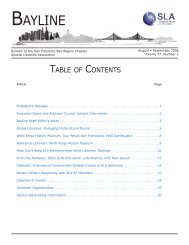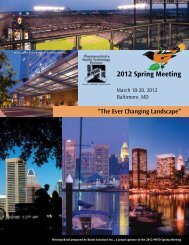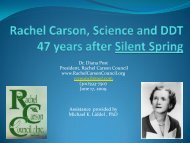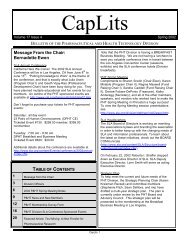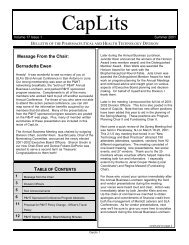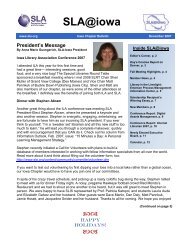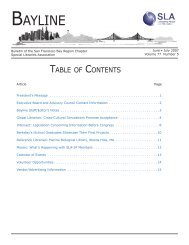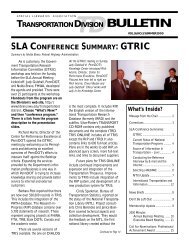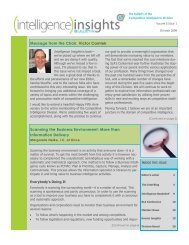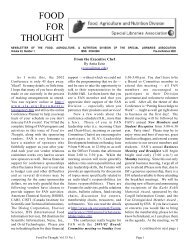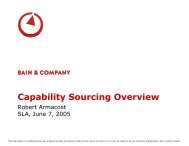Education Libraries - Special Libraries Association
Education Libraries - Special Libraries Association
Education Libraries - Special Libraries Association
You also want an ePaper? Increase the reach of your titles
YUMPU automatically turns print PDFs into web optimized ePapers that Google loves.
distributing the survey via Survey Monkey to 207<br />
institutions of which 144 or 67% completed the<br />
questions. The book includes an analysis of the survey<br />
results, the survey questions with the responses<br />
summarized, a selected bibliography, and copyright<br />
policy documents from sixteen colleges and universities.<br />
The survey found that campuses addressed the topic of<br />
downloaded music most often followed by audiovisual<br />
recordings, sound recordings and then images.<br />
Interlibrary loan, electronic research database licensing<br />
and reserves received the most attention in terms of<br />
monitoring and enforcing copyright. Photocopying and<br />
downloading scored lowest. According to the results, the<br />
majority of staff, faculty and students receive copyright<br />
training either annually or “on demand.”<br />
From reading the responses regarding copyright<br />
education, the reader gains a picture of the similar ways<br />
in which various colleges treat this important topic. For<br />
example, many institutions discuss copyright during<br />
orientation sessions, at the beginning of the school year.<br />
In most cases, the library initiates the discussions.<br />
The real core of this CLIP Notes, however, lies in its<br />
assortment of copyright policies. The sampling here<br />
from Albion College, Goucher, Earlham, SUNY at<br />
Plattsburgh, and Wheaton to name just a few, covers this<br />
topic with depth and practically. These policies are<br />
wonderful guides upon which to base your own library’s<br />
policy.<br />
This CLIP Note as with others in the series is an<br />
invaluable tool for all libraries. The results of the survey<br />
plus the copyright policies make it a must-have.<br />
References<br />
Clip Notes: Guidelines for compilers. (2006). Chicago:<br />
College <strong>Libraries</strong> Section, <strong>Association</strong> of College and<br />
Research <strong>Libraries</strong>, American Library <strong>Association</strong>.<br />
Retrieved from:<br />
http://www.ala.org/ala/acrl/aboutacrl/acrlsections/collegel<br />
ibraries/collpubs/clipnotesguidelines.cfm#intro<br />
Morein, P.G. (May 1985). What is a CLIP note? C & RL<br />
News: College and research libraries news, 46: 226-229.<br />
Tuten, J., & Jones, B. comp. (1995). Allocation formulas in<br />
academic libraries. CLIP Notes #29. Chicago:<br />
<strong>Association</strong> of College and Research <strong>Libraries</strong>.<br />
Jacqueline Snider is co-editor of this journal, and<br />
adjunct faculty at The University of Iowa. Email:<br />
Jacqueline-snider@uiowa.edu<br />
.<br />
Why Do English<br />
Language Learners<br />
Struggle with<br />
Reading?:<br />
Distinguishing<br />
Language<br />
Acquisition from<br />
Learning<br />
Disabilities—<br />
Reviewed by<br />
Rachel L. Wadham<br />
Klingner, J. K.,<br />
Hoover, J. J., &<br />
Baca L. M. (Eds.)<br />
(2008). Why Do<br />
English Language<br />
Learners Struggle<br />
with Reading?:<br />
Distinguishing<br />
Language<br />
Acquisition from<br />
Learning<br />
Disabilities.<br />
Thousand Oaks, CA:<br />
Corwin Press. ISBN<br />
978-1-4129-4147-1.<br />
$31.95<br />
One of the challenging issues educators face today is<br />
how to successfully integrate English Language Learners<br />
(ELLs) into our school environments. With an<br />
unprecedented growth of the ELL population and federal<br />
mandates for assessment, one of the most significant<br />
challenges is determining if and when ELLs are<br />
underachieving. However, determining achievement<br />
potential is a complex business when it comes to ELLs.<br />
There are several reasons why ELL students may be<br />
underachieving and it is essential to determine if<br />
students are struggling because of the language<br />
acquisition process, instructional practices, learning<br />
disabilities, or a combination of factors. In order to give<br />
students the support they need, the first step is to<br />
determine the reasons for their difficulties. When the<br />
wrong determination is made, ELLs are often<br />
inappropriately referred to special education.<br />
This is where Why Do English Language Learners<br />
Struggle with Reading?: Distinguishing Language<br />
Acquisitions From Learning Disabilities comes in. This<br />
practical book, edited and written by specialists in<br />
bilingual and special education, attempts to provide<br />
<strong>Education</strong> <strong>Libraries</strong>, Volume 31, No. 2, Winter 2008 56



